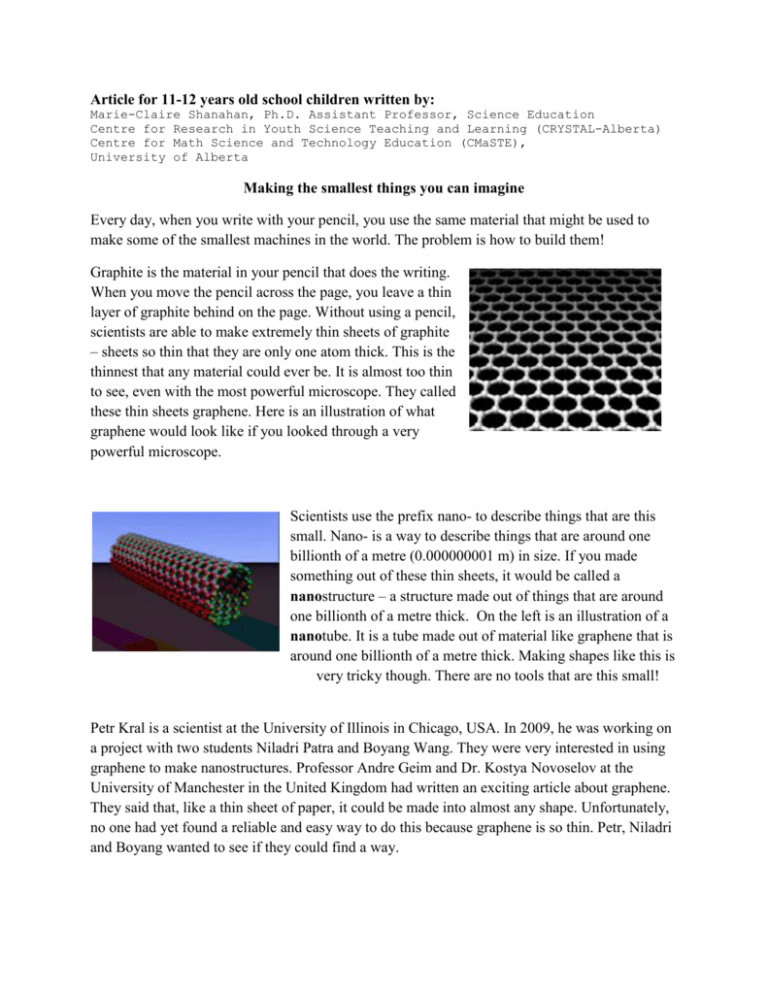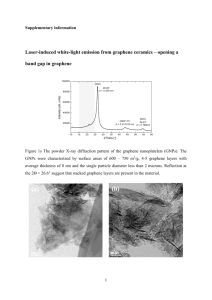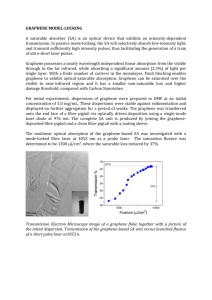Nanostructures
advertisement

Article for 11-12 years old school children written by: Marie-Claire Shanahan, Ph.D. Assistant Professor, Science Education Centre for Research in Youth Science Teaching and Learning (CRYSTAL-Alberta) Centre for Math Science and Technology Education (CMaSTE), University of Alberta Making the smallest things you can imagine Every day, when you write with your pencil, you use the same material that might be used to make some of the smallest machines in the world. The problem is how to build them! Graphite is the material in your pencil that does the writing. When you move the pencil across the page, you leave a thin layer of graphite behind on the page. Without using a pencil, scientists are able to make extremely thin sheets of graphite – sheets so thin that they are only one atom thick. This is the thinnest that any material could ever be. It is almost too thin to see, even with the most powerful microscope. They called these thin sheets graphene. Here is an illustration of what graphene would look like if you looked through a very powerful microscope. Scientists use the prefix nano- to describe things that are this small. Nano- is a way to describe things that are around one billionth of a metre (0.000000001 m) in size. If you made something out of these thin sheets, it would be called a nanostructure – a structure made out of things that are around one billionth of a metre thick. On the left is an illustration of a nanotube. It is a tube made out of material like graphene that is around one billionth of a metre thick. Making shapes like this is very tricky though. There are no tools that are this small! Petr Kral is a scientist at the University of Illinois in Chicago, USA. In 2009, he was working on a project with two students Niladri Patra and Boyang Wang. They were very interested in using graphene to make nanostructures. Professor Andre Geim and Dr. Kostya Novoselov at the University of Manchester in the United Kingdom had written an exciting article about graphene. They said that, like a thin sheet of paper, it could be made into almost any shape. Unfortunately, no one had yet found a reliable and easy way to do this because graphene is so thin. Petr, Niladri and Boyang wanted to see if they could find a way. They thought about lots of different ways to build things. One way to build a shape is like making a sculpture out of soap or clay. You start with a big block of soap or clay and you can carve up the block until it looks that way that you want it to. The other way to build something is like building with pipe cleaners or Lego – you take lots of smaller pieces and bring them together until you get what you want. Petr, Niladri and Boyang realized that graphene nanostructures might be easier to build more like pipe cleaners than clay. They began to look for ways to shape graphene into the shapes they wanted and assemble those pieces. To make it easier to see and think about the graphene, they created a computer model of it. This way, they could look at it easily and try many different ways to shape it. One thing they wondered about was whether water could be used to shape the graphene. In their previous research, Boyang and Petr had found that nanotubes (like the one in the picture above) can act like a railroad for moving water around. They had also read that other scientists had found that nanotubes could wrap themselves around underwater bubbles to create rings. Both of these pieces of evidence suggested to them that water might be able to shape graphene. They decided to use their computer model to test this hypothesis. Here is a copy of the report that Petr, Niladri and Boyang wrote for the scientific journal Nano Letters. Writing for this journal is a way for them to share what they found with other scientists. Other scientists who are interested in building nanostructures with graphene can learn from Petr, Niladri and Boyang. Water Droplets Shape Graphene Nanostructures Niladri Patra, Boyang Wang, and Petr Král Department of Chemistry, University of Illinois at Chicago, Chicago, Illinois, 6067, USA The main idea behind a “bottom-up’ approach to building is to find a way to guide smaller pieces to come together to form a final product. This approach is easier and uses less material than a “top-down” approach where material is removed to create a final product. Guiding materials to come together when they are very small, though, is difficult. To solve this problem, we need to find ways to use other tiny particles to guide the materials to come together. One suggestion has been to use water to shape the graphene. Carbon nanotubes can serve as a railroad for small water droplets. And nanotubes that are underwater can shape themselves into rings around bubbles of air. The question is if tiny droplets of water (nanodroplets) can guide the shape of graphene. To answer this question, we first study the effect of nanodroplets on a graphene sheet. It turns out that the droplets each create a shallow hole in the graphene sheet. As shown in Figure 1, two droplets on opposite sides of a graphene sheet create two shallow holes. Figure 1. A sideview of two nanodroplets of water Intrigued by the holes created by each droplet, we test to see if droplets can turn graphene into other shapes. We design a star shaped piece of graphene with four petals. It can be seen in Figure 2. Figure 2e shows the top view and Figure 2f shows the side view. A small droplet of water is placed in the centre of the star and causes the four petals to bend upward. Figure 2g and Figure 2f show the new shape. This shape resembles a “meat eating flower” where the graphene surrounds the water droplet and can protect it. Figure 2. Water droplet shaping a graphene flower. Finally, we test if nanodroplets can fold long ribbons of graphene. As shown in Figure 3, we use long ribbons with one end held still. The droplet is placed at the other end. When the droplet is placed there, the end of the ribbon wraps around the water droplet and folds to create a loop. Figure 3. A graphene ribbon folding into a loop. In summary, we have demonstrated that water droplets can cause graphene to bend and fold. This bending and folding can lead to rings, flower shapes, loops and knots. These shapes can be the building blocks of future nanodevices. In their article, Petr, Niladri and Boyang tell us and other scientists how they found a way to use water to make graphene into several different shapes. And just like when you use pipe cleaners to make an animal, they can now use the smaller shapes to make larger things. In an interview, Petr said that in the future they might be able to build things out of graphene that can join into living cells. Other scientists are trying to find ways to use nanodevices like those made from graphene to improve cancer diagnosis tests. They hope that nanodevices will actually be able to enter into people’s cells to detect cancer. Petr and his students are studying how graphene could be used to take salt out of water. This might make it easier for people who live beside the ocean to use ocean water as drinking water. What would you want to build if you could build something as small as this?






